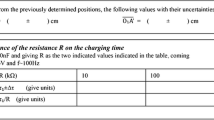Abstract
We want physics specialized high school and college students to think like physicists, and this involves an understanding of the scientific methods of inquiry and the ability to use these methods in their own investigations. In order to do that, students have to be made aware that no experimental result has any physical meaning unless an estimate of the uncertainty or precision is assigned to it. In this paper, we describe two simple experiments in which high school and college students measure physical constants, and make an easy analysis of their experimental data by applying the tools offered by microcomputers.
Similar content being viewed by others
REFERENCES
Black, P. (1993). The purposes of science education. In Hull, R. (Ed.), ASE Secondary Science Teachers' Handbook, Simon and Schuster, London, p. 6.
Deacon, C. (1992). Error analysis in the introductory physics laboratory. The Physics Teacher 30: 368-370.
Johnston, B., and Schroeer, J. (1992). Take-home experiments for large lecture classes. The Physics Teacher 30: 94-95.
Kagan, D. (1989). A brief experiment to illustrate the relationship between statistics and measurement. The Physics Teacher 27: 44-45.
Lubben, F., and Millar, R. (1996). Children's ideas about the reliability of experimental data. International Journal of Science Education 18: 955-968.
Millar, R. (1998). Students' understanding of the procedures of scientific inquiry. In Tiberghien, A., Jossem, E., and Barojas, J. (Eds.), Connecting Research in Physics Education With Teacher Education [Online]. Retrieved June 5, 1998, from http://www.physics.ohio-state.edu/»jossem/ICPE/ BOOKS.html
Roberts, D. (1983). Errors, discrepancies, and the nature of physics. The Physics Teacher 21: 155-160.
Robinson, P. (1991). Laboratory ManualWith Computer Activities, Addison-Wesley, Reading, MA, p. 218.
Shulman, L., and Tamir, P. (1973). Research on teaching in the natural sciences. In Travers, R. (Ed.), Second Handbook of Research in Teaching, Rand McNally, Chicago, IL, pp. 1098-1148.
T. D. M. (1973). Etcetera. The Physics Teacher 11: 191.
Thomsen, V. (1997). Precision and the terminology of measurement. The Physics Teacher 35: 15-17.
Author information
Authors and Affiliations
Rights and permissions
About this article
Cite this article
Trumper, R. What Do We Expect from Students' Physics Laboratory Experiments?. Journal of Science Education and Technology 11, 221–228 (2002). https://doi.org/10.1023/A:1016016417872
Issue Date:
DOI: https://doi.org/10.1023/A:1016016417872




